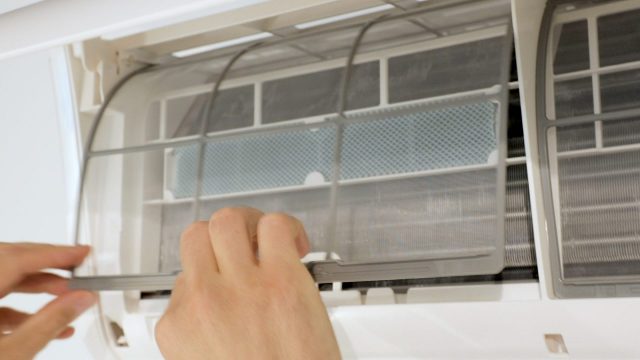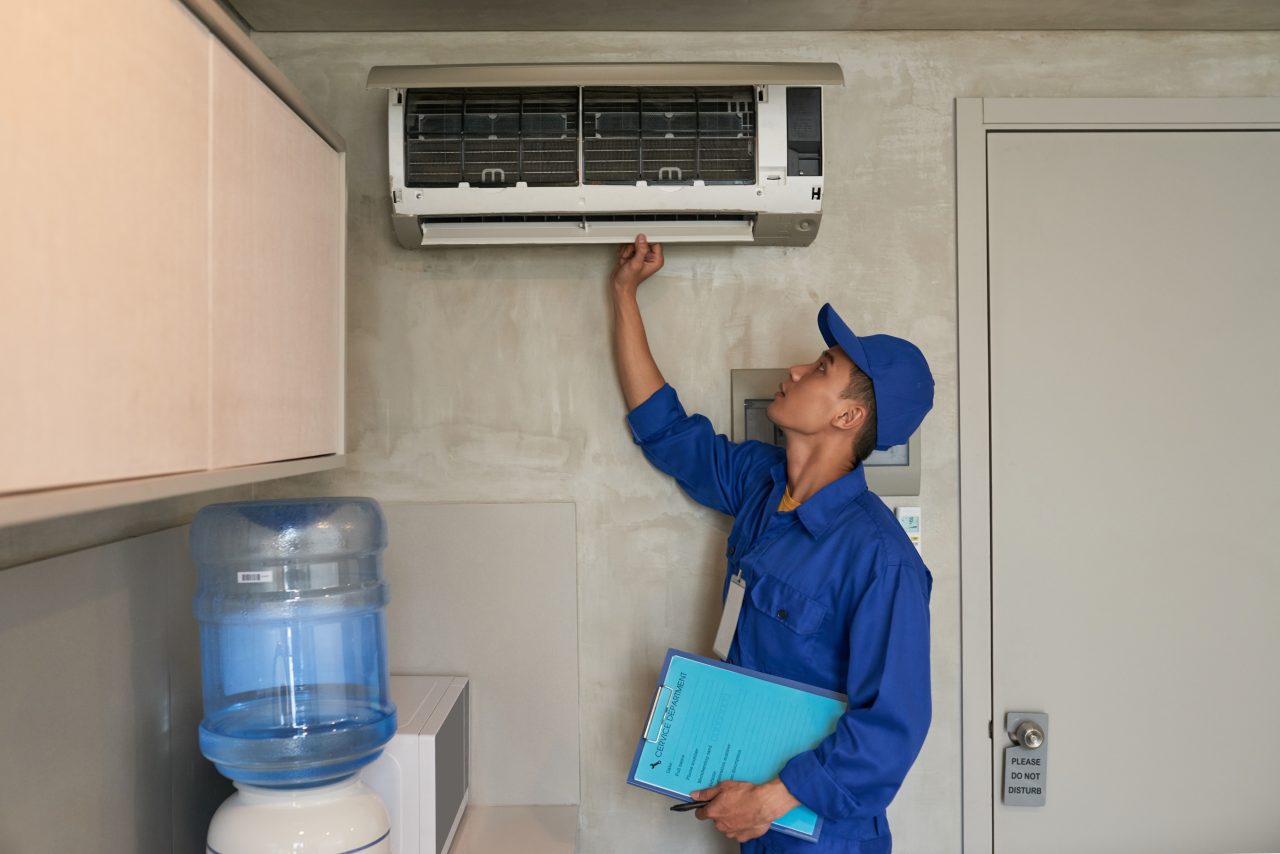Discover easy-to-follow guides on your air conditioning unit or HVAC repair and care, covering essential tips like changing air filters, professional inspections, and ductwork checks. Learn how to get the best from ceiling fans and air conditioning unit or HVAC for a comfy home. Understand the importance of balancing humidity levels for a healthier living space. Discover why it’s wise to leave air conditioning troubleshooting to experts like ADK Kooling, offering quick service, clear pricing, available parts, and a 90-day repair warranty. If you are interested to buy a new air conditioning unit, Explore the discounted deals at Rimy’s.
Here’s few hacks that may help you, Let’s delve in it.
Regular Air Filter Changes
Regularly changing the air filter is a fundamental practice that significantly impacts the effectiveness and lifespan of your air conditioning unit. This straightforward yet crucial task is more than just a maintenance routine; it serves as a proactive measure to enhance system performance, ensure healthier indoor air, and mitigate the likelihood of expensive repairs. The air filter in your HVAC system acts as a barrier against dust, dirt, pollen, and other airborne particles. Over time, these particles accumulate on the filter, obstructing the airflow and making your system work harder to maintain the desired temperature.

By routinely changing the air filter, you alleviate this strain on the system, promoting efficient operation and preventing unnecessary wear and tear. Moreover, the simple act of changing the air filter plays a pivotal role in extending the overall lifespan of your HVAC. A well-maintained system is less prone to breakdowns and malfunctions, reducing the likelihood of HVAC repair or the need for premature replacements. This, in turn, translates to long-term cost savings and sustained comfort in your home.
Now, let’s delve into a detailed guide on how to change your air filter, that any homeowner can easily perform. This hands-on approach empowers individuals to take control of their HVAC repair, fostering a sense of responsibility for the well-being of their home environment.
- Check your air conditioning unit owner’s manual to find the air filters’ location. It’s commonly inside the air handler unit, in a designated slot on the furnace, or within a return air grille.
- Ensure safety by switching off your air conditioning unit before changing the air filter. This prevents the system from drawing in air while you’re working.
- Gently slide out the old filter, or if it’s in a grille, remove screws or latches to access it. Note the size and orientation of the old filter for reference.
- Check the old filter for dirt and debris. If it’s visibly dirty or clogged, replace it to maintain optimal system performance.
- Refer to your owner’s manual for the correct filter size and type. Insert the new filter with arrows or airflow indicators facing the blower motor or as specified on the filter.
- Ensure the new filter is securely in place. If covers, screws, or latches were removed, replace them to prevent air bypass and maintain system integrity.
- Once the new filter is secure, turn the air conditioning unit back on. Monitor for any unusual noises, ensuring everything functions correctly with the new filter.
- Most filters need replacement every 1 to 3 months, but this may vary based on filter type and household conditions.
Scheduled Pro Inspections
Scheduled professional inspections stand as a cornerstone in maintaining the optimal performance, efficiency, and longevity of your Air conditioning Unit. Conducted by trained engineers, these inspections offer a proactive approach to identify potential issues before they escalate into major problems, preventing unexpected breakdowns and mitigating the need for costly HVAC repair. Safety checks are integral to the process, particularly for gas-based heating systems, as technicians diligently identify potential gas leaks or combustion issues to ensure safe operation.Indoor air quality is another critical aspect assessed during these inspections.

Engineers evaluate factors such as dust accumulation, mold growth, or other pollutants, contributing to a healthier living environment. Moreover, scheduled professional inspections align with manufacturer recommendations, upholding warranty conditions and safeguarding your investment. Key aspects of these inspections include filter replacement to maintain optimal airflow, refrigerant level checks for air conditioning unit, examination of the electrical system for signs of wear or damage, calibration of the thermostat for accurate temperature control, and an inspection of the ductwork to identify leaks or blockages that your HVAC repair needed.Professionals also undertake the cleaning of condenser and evaporator coils, essential for preventing dirt buildup that can compromise efficiency and strain the air conditioning unit. The inspection provides a holistic evaluation of the entire air conditioning unit, covering both heating and cooling components, offering valuable insights and recommendations for improving performance and efficiency through frequently hvac repair .Scheduling these inspections biannually/annually is a general recommendation. However, for systems with heavy usage or those in extreme climates, more frequent inspections, such as semi-annual checks, may be advisable.
Ductwork Check and Sealing:
Conducting a DIY ductwork check and sealing process is a fundamental step to enhance the efficiency and performance of your HVAC system. Ducts are responsible for distributing conditioned air throughout your home, and any leaks or issues can result in energy wastage and compromised comfort.
Here’s a detailed yet concise process for homeowners to assess and seal ductwork on their own:
- Start by visually inspecting your ductwork. Look for visible signs of damage, such as gaps, holes, or disconnected sections. Pay close attention to joints, seams, and connections. If accessible, inspect ducts in attics, basements, crawl spaces, or any other areas where they may be exposed.
- Feel for air leaks around the ducts while your HVAC system is running. Use your hands to detect any escaping air or employ a smoke pencil to visually identify leaks. Common indicators include hissing sounds or dust being blown from the ducts. Mark the locations of identified leaks for later sealing.
- Once leaks are identified, the next step is sealing. For small gaps or holes, mastic sealant or metal-backed tape designed for HVAC use can be effective. Apply the sealant or tape directly over the leak, ensuring a tight seal. For larger gaps, consider using foil-faced tape or mastic along with fibreglass mesh for added reinforcement. Ensure the sealing material is compatible with your duct material.
- In addition to sealing leaks, consider insulating ducts in unconditioned spaces. This helps maintain the temperature of the air travelling through the ducts and minimises energy loss. Use insulation specifically designed for ductwork, such as foil-faced fibreglass insulation, and secure it tightly with tape.
- After sealing and insulating, repeat the visual inspection and air leak detection process to ensure all potential issues have been addressed. Check for any new leaks that may have emerged during the sealing process might need HVAC repair
- Finally, monitor your HVAC performance after the DIY ductwork check and sealing. Observe any improvements in airflow, temperature consistency, and energy efficiency. If issues persist, or if the ductwork is complex and extensive, it may be advisable to seek professional assistance for a more thorough evaluation and sealing.
Benefits of Ceiling Fans and HVAC Systems in Your Home
Making smart choices with your ceiling fans and HVAC systems can greatly improve the comfort of your home, and each option has its own advantages. Ceiling fans are excellent for saving energy and money, creating a pleasant breeze in certain rooms. They are easy to maintain and work well all year round, providing cooling in the summer and helping distribute warm air in the winter. On the other side, HVAC systems give you complete control over your home’s temperature, ensuring a consistent environment. These systems also clean the air and manage humidity, promoting a healthier home. However, they come with a higher upfront cost and require regular professional check-ups or HVAC repair. Combining both options can be a successful approach – use ceiling fans to cool specific areas and support your HVAC system, making your home comfortable and energy-efficient and there will be less cost for the HVAC repair. The key is finding what best fits your needs and preferences!
Balance Humidity Level
Maintaining the right humidity level in your home is more than just a comfort factor—it’s a key element for a healthy living space. This guide is designed to provide you with detailed steps to effectively manage humidity, ensuring that your indoor environment remains comfortable and conducive to well-being.
- Measure Humidity: Before making any adjustments, start by measuring the humidity using a hygrometer. The sweet spot is typically between 30% and 50%, providing a comfortable and healthy baseline.
- Ventilation: Keep your home well-ventilated. Use exhaust fans in areas prone to moisture, like bathrooms and kitchens. If needed, consider a whole-house ventilation system to maintain a consistent airflow.
- Use Dehumidifiers: Combat high humidity areas with dehumidifiers, especially during warmer seasons. These devices work efficiently to extract excess moisture, ensuring a balanced and optimal humidity level.
- Repair Leaks: Swiftly address leaks and water damage. Beyond preventing humidity spikes, quick fixes also thwart potential mould growth, maintaining a dry and healthy indoor environment.
- Air Conditioning: Ensure your air conditioning unit is appropriately sized to prevent rapid cooling, which can leave indoor air feeling damp. Regularly clean AC filters to facilitate efficient moisture removal and HVAC repair as a proactive approach.
- Use Houseplants: Harness the natural humidity-regulating properties of certain houseplants like peace lilies and spider plants. Just be mindful not to overwater, striking a balance between green aesthetics and humidity control.
- Seal Windows and Doors: Check for gaps and seal them to keep outdoor humidity from infiltrating your indoor space. Employ weatherstripping and caulking as effective tools in this effort.
- Regular Maintenance: Regularly service appliances like HVAC systems and dehumidifiers. Clean filters and coils to ensure optimal performance in moisture control.
Looking for new Air Conditioning Unit? Explore the best discounted deals at Rimy’s
Spotted signs your air conditioning unit is making some trouble? It’s probably time to call in the experts.
All sorts of little things can go wrong with the Air Conditioning Unit. Some are very minor and can be fixed at home procedures or a quick clean. But others may require a specialist diagnosis and repairs.
But be warned: it could get you into trouble if you attempt to make the repairs yourself without the right training or know-how. It isn’t advisable, and it might put off an engineer from ADK Kooling to work on them if the problem isn’t resolved.
If you live within the M25 and your air conditioning unit is showing one or more of these telltale signs of dying — then I’d like to suggest you give one of our specialists a call.
Some reasons to consider us include:
- Our engineers can get out to you in just a few hours.
- Our call-outs are set at fixed prices — with no sneaky hidden extra charges.
- We carry lots of spare and replacement parts, so it’s extremely unlikely you’ll have to wait around for us to order one.
- We can guarantee a 90-days warranty on all our repairs
Find out more about our air conditioning repairs & get an engineer out ASAP.

